Published: 28 August 2018
Index of wage and salary earnings rose by 1.8 percent in April-June
According to preliminary data of Statistics Finland, the nominal earnings of wage and salary earners rose by 1.8 per cent in April to June 2018 when compared with the respective period in 2017. Real earnings rose by 0.8 per cent compared to the second quarter of the previous year, because the rise in earnings level was faster than that in consumer prices.
Index of wage and salary earnings and real earnings 2000/1 to 2018/2, annual change percentage
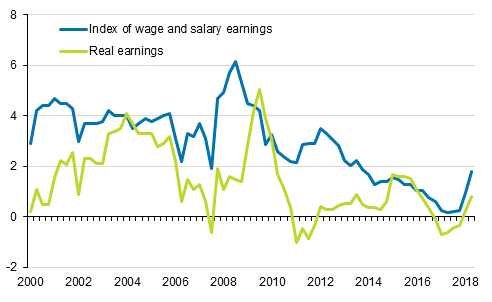
According to Statistics Finland’s preliminary data, the nominal earnings of wage and salary earners rose from April to June 2017 to the corresponding period in 2018 by 1.9 per cent in the private sector, by 1.6 per cent in the central government sector and by 1.3 per cent in the local government sector.
Wage and salary earners’ regular earnings increased by 1.8 per cent in April to June
The index for regular earnings describes the permanent change in earnings better than the index of wage and salary earnings because it does not take into account performance-based bonuses and non-recurring items included in collective agreements. Regular earnings rose by 1.8 per cent in April to June 2018 when compared with the respective period in 2017. The growth amounted to 1.9 per cent in the private sector, to 1.6 per cent in the central government sector, and to 1.3 per cent in the local government sector.
The indices of wage and salary earnings and the indices for regular earnings are final as far as the year 2017. They are based on the realised earnings development. The indices for 2018 are preliminary and they are based on estimates of agreement effects and the wage drift.
According to preliminary data, earnings of wage and salary earners were 2.0 percent higher in July to September than in the year before
According to Statistics Finland’s preliminary data, the nominal earnings of wage and salary earners are 2.0 per cent higher in July to September 2018 than in July to September 2017. According to preliminary data, the index of wage and salary earnings 2015=100 for the third quarter of 2018 is 103.2. Statistics Finland compiles the preliminary third quarter data for the index of wage and salary earnings on the basis of the Employees Pensions Act (2006/395).
Effects of the Competitiveness Pact visible in earnings development
On the Government's initiative, labour market organisations concluded in summer 2016 the Competitiveness Pact, which aimed to improve the competitiveness of Finnish enterprises and create new jobs. In the Competitiveness Pact, labour market organisations agreed on reducing public sector holiday bonuses, extending annual working time and extending collective agreements. The sections below examine how the effects of the Competitiveness Pact are visible in the development of the index of wage and salary earnings and the index for regular earnings.
Cut in public sector holiday bonuses has an effect on the index of wage and salary earnings
It was agreed in the Competitiveness Pact that public sector holiday bonuses would be reduced by 30 per cent in the years 2017 to 2019. The figure examines the development of the index of wage and salary earnings (ATI) and the index for regular earnings (SANI) in 2015 to 2018. The examination ends in the last published quarter, that is, the second quarter of 2018. In the Competitiveness Pact, the cut in public sector holiday bonuses is visible in the central and local government sectors, in both of which the index of wage and salary earnings fell in the first quarter of 2017 and the earnings development was negative in 2017. A corresponding fall is not visible in the index for regular earnings because it does not take into account performance-based bonuses and non-recurring items included in collective agreements. Cuts in holiday bonuses are considered non-recurring items based on collective agreements so they are included in the index of wage and salary earnings but not in the index for regular earnings.
Development of the index of wage and salary earnings and the index for regular earnings 2015=100 by employer sector
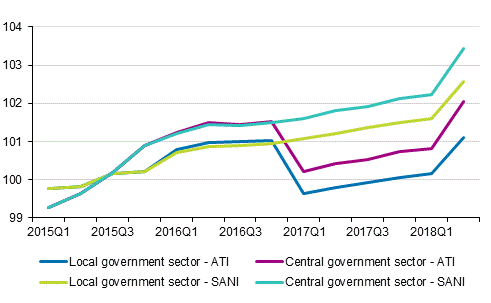
The cut in public sector holiday bonuses is also visible in earnings development by industry. The figure below shows the development of the index of wage and salary earnings 2005=100 in the industries of manufacturing, trade, public administration and health and social work in 2005 to 2017. The examination ends in 2017 because the data of the index of wage and salary earnings are final as far as that year. The majority of public sector wage and salary earners are employed in the industries of public administration and health and social work. In these industries, the index of wage and salary earnings falls in the first quarter of 2017 and the earnings development was negative in 2017. A corresponding fall did not appear in manufacturing and trade, for instance.
Development of the index of wage and salary earnings 2005=100 by industry (TOL2008)
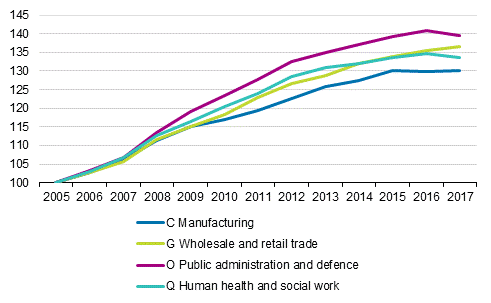
Effect of extended working time is eliminated in the index of wage and salary earnings and the index for regular earnings
In the Competitiveness Pact, labour market organisations agreed on extending working time by 24 hours per year without changing the earnings level. The extension of working time was mainly implemented during 2017 in those fields that have joined the Pact. Their coverage is good 90 per cent of wage and salary earners. In some, particularly smaller enterprises the extension was not implemented although the enterprise is in a field belonging to the scope of the Pact.
The extension of working time agreed in the Competitiveness Pact has thus had a negative effect on hourly earnings, but it has not had an effect on monthly earnings. The index of wage and salary earnings and the index for regular earnings measure earnings for regular hours on the monthly level. In principle, the extension of working time is thus not visible in these indices. The earnings development of hourly-paid employees is, however, measured from hourly earnings, so the effect of the Competitiveness Pact is taken into account in the calculation of the indices. Correction coefficients have been calculated in some fields with collective agreements to the index series so that the extension of working time would not cause a negative effect on the indices of these fields. In some fields with collective agreements, the Competitiveness Pact has been implemented so that it has not affected the earnings for regular working hours, on which the calculation is based, but the changes caused by the Pact have been taken to irregularly paid bonuses. In some fields with collective agreements, there have been different alternatives for implementing the Competitiveness Pact, whereby its effect on hourly earnings cannot be accurately estimated. This has caused uncertainty in the calculation of earnings development in some fields between 2016 and 2017.
No collectively bargained pay increments in practice in 2017
In the Competitiveness Pact it was also agreed to extend collective agreements by 12 months so that wages and salaries remain unchanged for the duration of the extended agreement period. As a result, collectively bargained pay increments occurred only in individual industries in 2017.
The figure below examines the development of the index of negotiated wages and salaries 2010=100 in 2010 to 2018. Employer sectors total, private sector and local government sector were selected to the examination. The index of negotiated wages and salaries in the private sector remained unchanged in 2017 and turned upwards again in the first quarter of 2018, when collectively bargained pay increments have come into force. In the local government sector, the index of negotiated wages and salaries falls in the first quarter of 2017, because the reduction in public sector holiday bonuses is also visible in the development of the index of negotiated wages and salaries. In 2017, the index of negotiated wages and salaries in the local government sector remains unchanged and turns upwards in the second quarter of 2018, because the first overall increase in the collective agreement period was made in May 2018. In the central government sector, the development of the index of negotiated wages and salaries has in recent years largely followed the development of the index of negotiated wages and salaries in the local government sector.
Development of the index of negotiated wages and salaries 2010=100 by employer sector
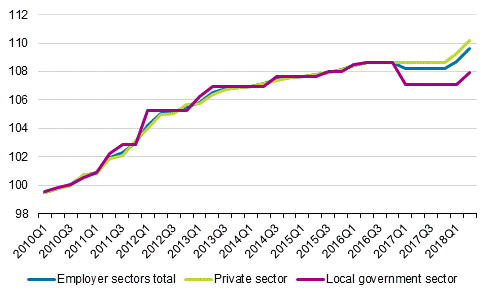
Change in occupational structure affects the development of average earnings
Statistics Finland has since 2013 published the index standardised with the main category of occupation based on the data of the index for regular earnings, where the shares of the main categories of occupation for each wage and salary earner group are standardised based on the wage and salary sum weights of 2010. There are ten of these main categories of occupation, from managers to other workers. By comparing the index standardised with occupation and the index for regular earnings, we can examine how changes in the occupational structure of the employer sector influence the development of average earnings in the same employer sector.
From 2010 to 2017, the change in the occupational structure has accelerated the rise in average earnings both in the central and local government sectors. The figure shows how the index for regular earnings has risen more in the central and local government sectors in 2010 to 2017 than the index standardised with occupation. The development is opposite in the private sector, that is, the index standardised with occupation has risen more than the index for regular earnings in 2010 to 2017.
Change in earnings by employer sector and according to the index for regular earnings and the index standardised with the main category of occupation 2010=100
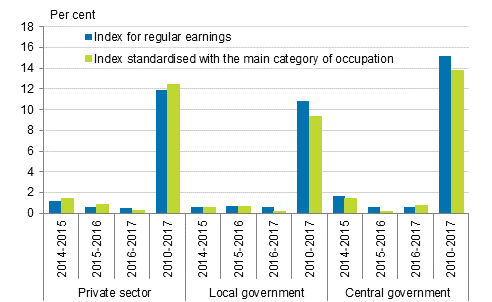
For example, in the occupational groups of professionals and managers, wage and salary earners usually have a higher university degree, and in these occupations the earnings level is also higher than average. The growth in the share of managers and professionals leads to a faster rise in average earnings. This is particularly visible in the earnings development of the central and local government sectors. In the private sector, the index standardised for occupation has risen in 2010 to 2017 more than the index for regular earnings, but in 2016 to 2017, for example, the index for regular earnings has risen more than the index standardised for occupation. At the same time, the share of professionals has grown in the private sector.
The employer sector-specific data of the index standardised with the main category of occupation can be found in the database table of the statistics on the index of wage and salary earnings (Index of regular earnings 2010=100 standardised with the main category of occupation).
Source: Index of wage and salary earnings 2018, 2nd quarter. Statistics Finland
Inquiries: Anu Uuttu 029 551 2322, Harri Nummila 029 551 3235, palkat.indeksit@stat.fi
Director in charge: Mari Ylä-Jarkko
Publication in pdf-format (496.9 kB)
- Tables
-
Tables in databases
Pick the data you need into tables, view the data as graphs, or download the data for your use.
Appendix tables
- Appendix table 1. Index of wage and salary earnings 2015=100 by employer sector and base of payment (28.8.2018)
- Appendix table 2. Index of regular earnings 2015=100 by employer sector and base of payment (28.8.2018)
- Appendix table 3. Index of wage and salary earnings 2015=100 by employer sector and gender (28.8.2018)
- Appendix table 4. Index of regular earnings 2015=100 by employer sector and gender (28.8.2018)
- Appendix table 5. Index of wage and salary earnings 2015=100 by industry, (TOL 2008) (28.8.2018)
- Appendix table 6. Index of regular earnings 2015=100 by industry, (TOL 2008) (28.8.2018)
- Appendix table 7. Index of wage and salary earnings 2010=100 by employer sector and gender (28.8.2018)
- Appendix table 8. Index of wage and salary earnings 2010=100 by industry, (TOL 2008) (28.8.2018)
- Appendix table 9. Index of wage and salary earnings 2015=100, percentage changes (28.8.2018)
- Appendix table 10. Index of regular earnings 2015=100, percentage changes (28.8.2018)
- Appendix table 11. Average earnings by employer sector and gender, EUR/month (28.8.2018)
- Revisions in these statistics
-
- Revisions in these statistics (28.8.2018)
Updated 28.08.2018
Official Statistics of Finland (OSF):
Index of wage and salary earnings [e-publication].
ISSN=1798-7814. 2nd quarter 2018. Helsinki: Statistics Finland [referred: 21.12.2025].
Access method: http://stat.fi/til/ati/2018/02/ati_2018_02_2018-08-28_tie_001_en.html

